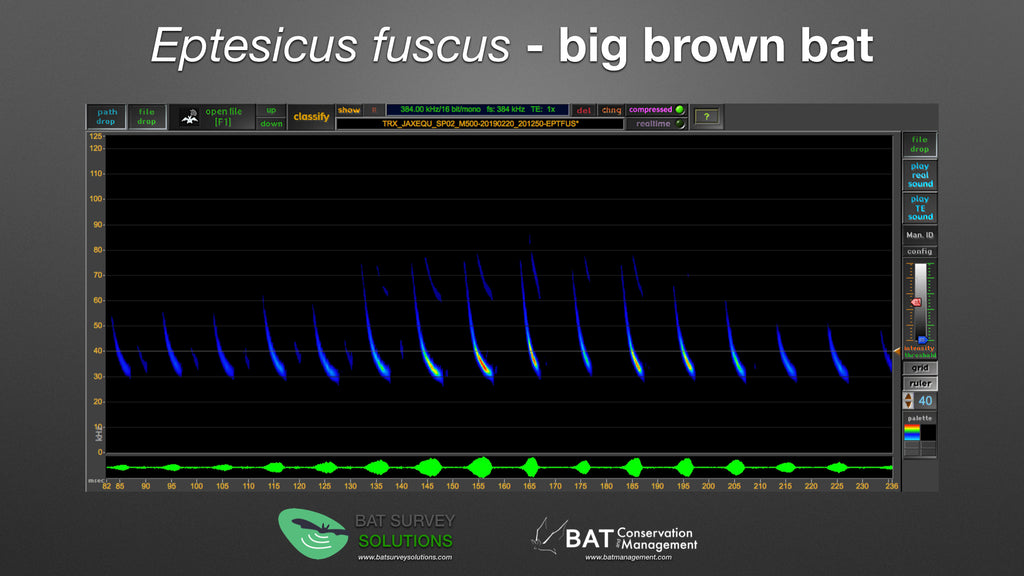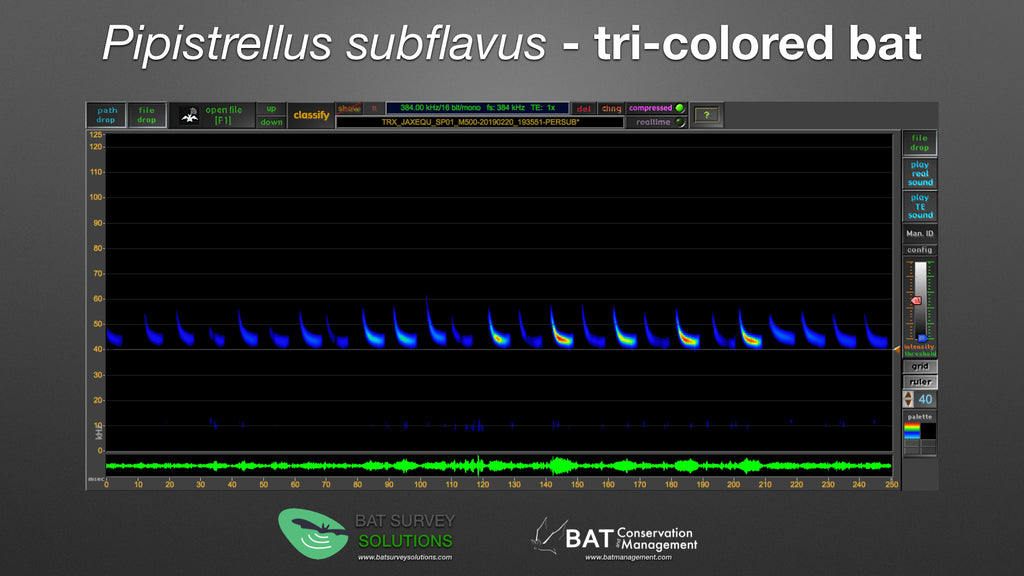Over 50 people participated in Bat Conservation and Management's SonoBat Walkabout just prior to the Southeast Bat Diversity Network's 2019 Florida meeting. After an afternoon of data management and bat call vetting mini-workshops, it was time to take an evening stroll around a local park in some misty rainy weather and see what, if any bats would be out and about. Led by Joe Szewczak, Bryan Butler, John Chenger, Todd Sinander, and Julie Zeyzus, then reinforced with Chris Corben and Kim Livengood, it was a force to be reckoned with.
We passed out 5-Surface Pro tablets loaded with SonoBatLIVE connected to Pettersson M500 microphones or Binary Acoustic Technology MiniMics. Almost 400 recordings were collected, representing over 500 bat passes (accounting for recordings with multiple bats in a file) during a 45-minute transect. This mini report only includes data from these five devices, and doesn't include Chris Corben's Anabat Walkabout data and observations. Interestingly and probably expected, no one device captured all six species. Chris claims to have recorded seven (everything SonoBat recorded, but also NYCHUM), so the takeaway is we need to clone Chris and place him at all our study site!

One hundred percent of this collection was manually vetted to species, species-guild or HiF/LoF divisions, by
Janet Debelak Tyburec; Bat Survey Solutions, LLC
These charts represent the summary information for the collection as a whole, and a breakdown of relative activity and species occurrence by the five different detectors on the transect.
NOTE: The collection included a total of 80 “noise” files containing no bat calls. These files were deleted prior to analysis. Time stamps were off on two of the recorders (an artifact of time zone changes), and one recorder did not include text notes or standard filename nomenclature (an artifact of meeting 50 people in a drizzle for a bat walk). Time stamps were not corrected for the analysis. Files were renamed to adhere to the standard nomenclature. Filenames and notes were easily fixed using the SonoBat Data Wizard. Even time itself can change using that app, if desired!
TADBRA was the dominant species recorded, making up nearly 50% of the recordings. About 1/4 of the recordings could not be confidently identified to species. Nearly 15% of the recordings had multiple individuals in the file.
Between 1-6% of the remaining recordings were made up of files from each of the following species EPTFUS, LASBOR, LASINT, MYOAUS, and PIPSUB.
Notes on EPTFUS, LASINT, and NYCHUM
Recordings from EPTFUS and LASINT should be carefully scrutinized, as few examples of highly confident archetypical examples for either species were collected from these transect. There is a good deal of overlap in many of the call characteristics from these two species, therefore, one or the other, or both, could be present in this collection.
Also, no sequences from NYCHUM were auto-classified by the SonoBat algorithms, nor were any convincing sequences identified during the manual vetting step. Several “FRAGLO” guilds and ambiguous EPTFUS/LASINT and EPTFUS/TADBRA sequences were designated during the manual vetting effort. These could be additionally scrutinized, but it is unlikely that they would yield disambiguous examples consistent with what is known for NYCHUM. A longer deployment at this location would be required to collect suitable high-quality calls to confidently identify these three species.
Manually vetted results from all other species are much more confident and include many examples of archetypical recordings known for each species. Screenshots of the archetypical recordings for each species follows. (Tip: To maximize the graph, right click on it and "open in new tab".)

For more information on bat acoustic data analysis services, project management, or training workshops please contact jchenger@batmanagement.com or jtyburec@batsurveysolutions.com.
Sample Species Call Sequences and Brief Description
Tho descriptions of archetypal call types are comprehensive, lack of space allows for presentation of only one graphic example that complements a portion of the known repertoire for each / any species.
Eptesicus fuscus - big brown bat
Typical call-shapes are shallowly sloped with characteristic frequencies that typically range from 25-30kHz, but can be as low as 21kHz or as high as 33kHz. Calls are usually curvilinear, with no obvious inflection. But, calls can be highly variable, with shorter duration, broader bandwidth calls being produced as the bat moves into more highly cluttered environments. In fact, EPTFUS will often produce very steeply sloped FM call pulses when flying thru close-in cluttered habitats, then switch all the way to long-duration, low frequency, narrow bandwidth flat calls for open-air foraging and navigation.

Lasiurus borealis - red bat
Lasiurus borealis has a very diverse repertoire, from nearly vertical, steeply sloped FM sweeps with large bandwidth and short durations to nearly flat, shallowly sloped QCF or CF pulses with extremely narrow bandwidth and long durations. This is because LASBOR will really vary its calls depending upon habitat and behavior. When in a more cluttered habitat, these bats produce the shorter duration, steeply sloped variants. As they move into more open habitats their calls become narrower in bandwidth, lower in slope and longer in duration.
Unfortunately, Seminole bat is acoustically ambiguous with the red bat. And this is a problem where the two species overlap. In these areas, they cannot be confidently classified to species. So when LASBOR classifications are made, they could just as easily actually be LASSEM. Sometimes dominant habitat types can be used to intuit which species is present, with LASBOR being more common around deciduous vegetation, and LASSEM more common in areas with large concentrations of Spanish moss, but these distinctions are not absolute. Therefore, everything that is said about LASBOR acoustically can also be said about LASSEM.

Lasiurus intermedius - northern yellow bat
This species has call characters that IDENTICAL to red bats, just 10kHz lower in Fc. This repertoire will give you a gestalt for the species, note how similar their call shapes are red bats, but overall the Fc generally oscillates above and below 30kHz, between 25-35kHz whereas LASBOR generally oscillates above and below 40kHz, between 35-45kHz.
Note the archetypical smoothly-shaped call pulses, the reverse-J shape, in the sequence, just like the red bat. And, just like the red bat, the yellow bat calls bounce around randomly in Fc throughout the sequence.

Myotis austroriparius - southeastern myotis
Myotis austroriparius produces a smoothly curved steep FM call, usually with little or no inflection, which begins steeply and then increases in curvature. Like most myotis, the calls may also have a well defined downward tail, but this is not always present, especially on sequences that are slightly out of range. On full-spectrum recordings, the peak power in the call typically persists for at least 1ms on non-saturated calls. This can be discerned by viewing the shape and size of the oscillogram (in green) below the calls.

Pipistrellus subflavus - tri-colored bat
Typical call pulses are made up of two distinct parts: (1) a very steep mostly vertical FM portion and (2) a very shallow nearly flat QCF or CF portion. These two parts come together at a distinct break or inflection (aka: knee or ledge) right at the Fc. This makes PERSUB calls bilinear, appearing “hockey stick” shaped.
Fc’s typically range from 41 to 44kHz but can be as low as 36 or as high as 47kHz. The Fc is also extremely consistent from pulse to pulse in a sequence, rarely varying more than 1kHz. One of the first thing that tips us off that this is not a Myotis is that these calls are rarely steeply sloped curvilinear FM pulses that sweep from the F-hi to the F-low and they do not have downward trending toes like we see in the Myotis.

Tadarida brasiliensis - Mexican free-tailed bat
Tadarida brasiliensis produces calls which are extremely variable in call shape, but generally produce two main call types: (1) nearly flat, QCF to CF dashed-line type “power forward” call and (2) a much more broad bandwidth, higher frequency, FM lazy-s shaped “power centered” call. Plus, there’s often a bit of a continuum between these two call types. Occasionally will produce “honks” that are nearly CF with Fc of 20kHz. Sequences can also be highly variable, with CF calls interspersed with one or two sequential inflected FM calls. And as the bat’s behavior switches from a typical commuting-phase to an approach-phase or acquisition-phase style, the calls become even higher in Fc, shorter in duration, and longer in bandwidth.






